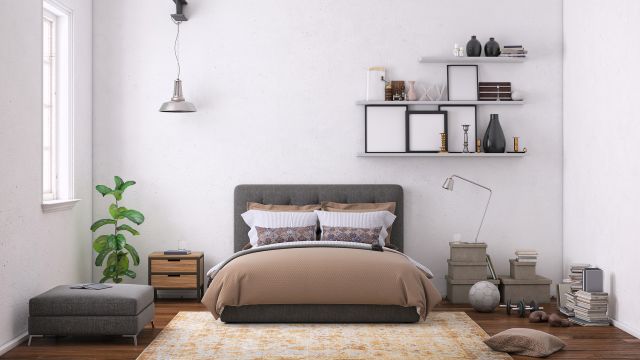Updated on October 1, 2024.
Good sleep can help you feel energized, lower your risk of disease, improve concentration, and so much more. You probably know that establishing good sleep hygiene—including winding down before bed, avoiding caffeine, and taking a warm bath—can contribute to better slumber. But did you know that your bedroom setup can also help you get a good night's rest?
From decor to temperature, here’s how to prepare your bedroom to help you get those recommended seven to nine hours of sleep each night.
Choose relaxing colors
Did you know that your bedroom decor can have an impact on your sleep? Your comforter, paint colors, and curtains can all help—or hurt—your shut-eye.
Experts advise that cool-tone colors like greens and blues may help you feel more relaxed, which is the mindset you want to be in as you wind down each night. On the other hand, brighter shades like red may interfere with your sleep and keep you awake.
Changing your paint color can be a tall order, but it’s not the only way you can add a sense of calm to your bedroom. If you feel like you could enhance the sense of calm your room provides, consider switching out your comforter, sheets, pillows, artwork, or blankets to muted shades.
Consider soothing scents
Studies are limited, but there is some indication that certain scents can help set the stage for better sleep. Lavender oil, for example, has been shown in small studies to contribute to lowered heart rate, blood pressure, and skin temperature.
While lavender is not a cure-all for sleep issues like insomnia, it doesn’t hurt to add oils, room spray, diffusers, or sachets in your room. Just be sure they don’t aggravate any allergies you might have. A scented candle may produce a pleasant aroma during the day when you’re awake. Look for candles made from natural wax like coconut, soy, or beeswax, and avoid those made from paraffin, a chemical typically derived from petroleum. Never leave candles lit overnight while you sleep.
Adjust the temperature
Being too hot or too cold can cause you to have trouble falling asleep or staying asleep.
If your room is cool, it will be easier to fall asleep, since your body temperature naturally decreases so you can snooze. Try setting your thermostat somewhere between 60 and 67 degrees Fahrenheit. A cooler room will also help you stay asleep—specifically in REM (rapid eye movement) sleep, the stage of sleep that involves dreaming.
Make sure your bedroom is dark
It’s also recommended that you keep your bedroom free of bright lights, televisions, computers, tablets, or cell phones. Exposure to light while sleeping can stimulate your brain and interfere with the production of the hormone melatonin. Melatonin levels naturally rise in the body around dusk, helping you become drowsy and ready for sleep.
Make sure all your lights are turned off and use curtains or eye masks if necessary. Blackout curtains can help if you live in an area with excessive street light. If you need a night light, invest in a low-illumination light. Try to avoid watching television, playing electronic games, or using your phone an hour before bedtime.
Change out your linens and mattresses regularly
It’s no surprise that a comfortable setup is going to help you sleep better, and that includes your bedding.
When it comes to your mattress, choose one that is supportive and feels good. You shouldn’t wake up with aches or pain. While there’s no set rule for when to change out your mattress, most last around eight years. If there are worn spots—or your position moves when your partner moves—it may be time to replace it. New smart mattress technology can monitor your temperature and track sleep quality, but these features often come at a much higher cost.
Replace pillows when they get lumpy, which tends to be after one to two years of use. It’s important to choose a pillow that feels comfortable to you and that suits your typical sleeping position. Side sleepers tend to need a fuller, more supportive pillow. Back sleepers typically need a slimmer pillow that supports the neck, while stomach sleepers are typically best-served by a thin pillow.
Keep your décor simple
Not everyone has the luxury of having multiple rooms throughout the home for work, entertainment, and sleep. But as much as possible, try to restrict your room to sleeping. That means setting up your home office in another part of your home and removing the television, as well.
It also helps to keep your bedroom free of papers, homework, or other clutter that might remind you of the stresses of the day.
Invest in a white noise machine
Noise can also affect your sleep in a negative way. When you hear sounds, your brain tries to process them, which can cause problems when you’re trying to fall asleep. Unexpected noises can also cause you to wake up in the middle of the night.
While noise affects everyone differently—some are more sensitive to it than others—it’s important to create a quiet environment for a good night’s sleep.
If you notice you’re having trouble with the noise in your room or home, try white noise machines or apps on your phone. White noise machines provide a constant sound, like a gentle whirring sound, that can block out disturbing outdoor sounds like traffic sirens. You can also achieve the same type of sound with an air purifier or fan. Other devices can produce calming nature sounds, like waves lapping on a beach or a gurgling stream.
Sleep is an essential part of a healthy lifestyle. Tracking your sleep using the free Sharecare app (for iOS and Android), can help you become aware of your sleep habits. By tracking your sleep duration and quality, you can work on establishing a sleep schedule and environment that works for you.







